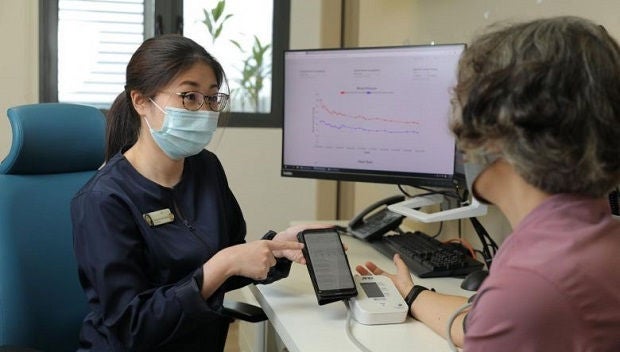
SINGAPORE - Patients with chronic health conditions such as diabetes have shown increased willingness to take up telemonitoring, a trend which is needed to help curb rising morbidity and mortality in Singapore's ageing population.
However, its feasibility depends on the patients' proactiveness and their acceptance of communication technologies for healthcare services, said SingHealth Polyclinics on Tuesday (Dec 15), which is currently recruiting more than 150 hypertension patients to test its effectiveness.
Telemonitoring involves remote monitoring of vital parameters of a patient, such as blood pressure or blood sugar levels, outside the healthcare setting.
SingHealth said it enables care providers to take prompt measures to prevent complications that develop in between visits, which may go unnoticed for patients who rely solely on physical consultations for chronic diseases.
Associate Professor Tan Ngiap Chuan, director of research at SingHealth Polyclinics, noted its use amid the coronavirus pandemic.
"This model of care has brought convenience to many of our patients, especially during the Covid-19 period, when we are advised to stay home," added Prof Tan, who is also vice-chairman of research of the SingHealth-Duke NUS Family Medicine Academic Clinical Programme.
He said that with government agencies launching technology literacy programmes, such as the Smart Nation Singapore initiative, more patients can accept and adopt communication devices to manage their health.
To demonstrate the uptick in telemonitoring, SingHealth cited two studies it previously conducted.
While research in 2009 showed that only 40 per cent of patients were receptive to it, a 2017 study it conducted with the National University of Singapore's Yong Loo Lin School of Medicine demonstrated that more than 52 per cent of patients had "positive perception and attitude" towards telemonitoring.
The 2017 study involved 900 Asian patients of various ethnicity between the ages of 21 to 70, who were assessed at the Pasir Ris and Sengkang polyclinics. They had chronic conditions such as Type 2 diabetes mellitus and hypertension.
The patients' willingness to adopt telemonitoring depended on their perception towards their medical conditions, their technological literacy and their understanding of telemonitoring care, said SingHealth, which has eight polyclinics islandwide and has recorded over 700,000 patient visits for hypertension and Type 2 diabetes mellitus.
Dr David Sin, who will join the SingHealth Family Medicine Residency next July, noted that patients without any need for financial assistance were more willing to use telemonitoring.
Dr Sin, who is currently a medical officer with the Singapore Armed Forces, added: "In contrast, patients who set aside more time for polyclinic visits, and those who had concerns regarding privacy violations were less willing to embark on this care model."
To further test the effectiveness of telemonitoring on maintaining a patient's health, a pilot programme for hypertension patients - called the Primary Tech-Enhanced Care at Bedok Polyclinic - was launched on Sept 30.
It has recruited close to 25 patients to date.













 Get it on Google Play
Get it on Google Play